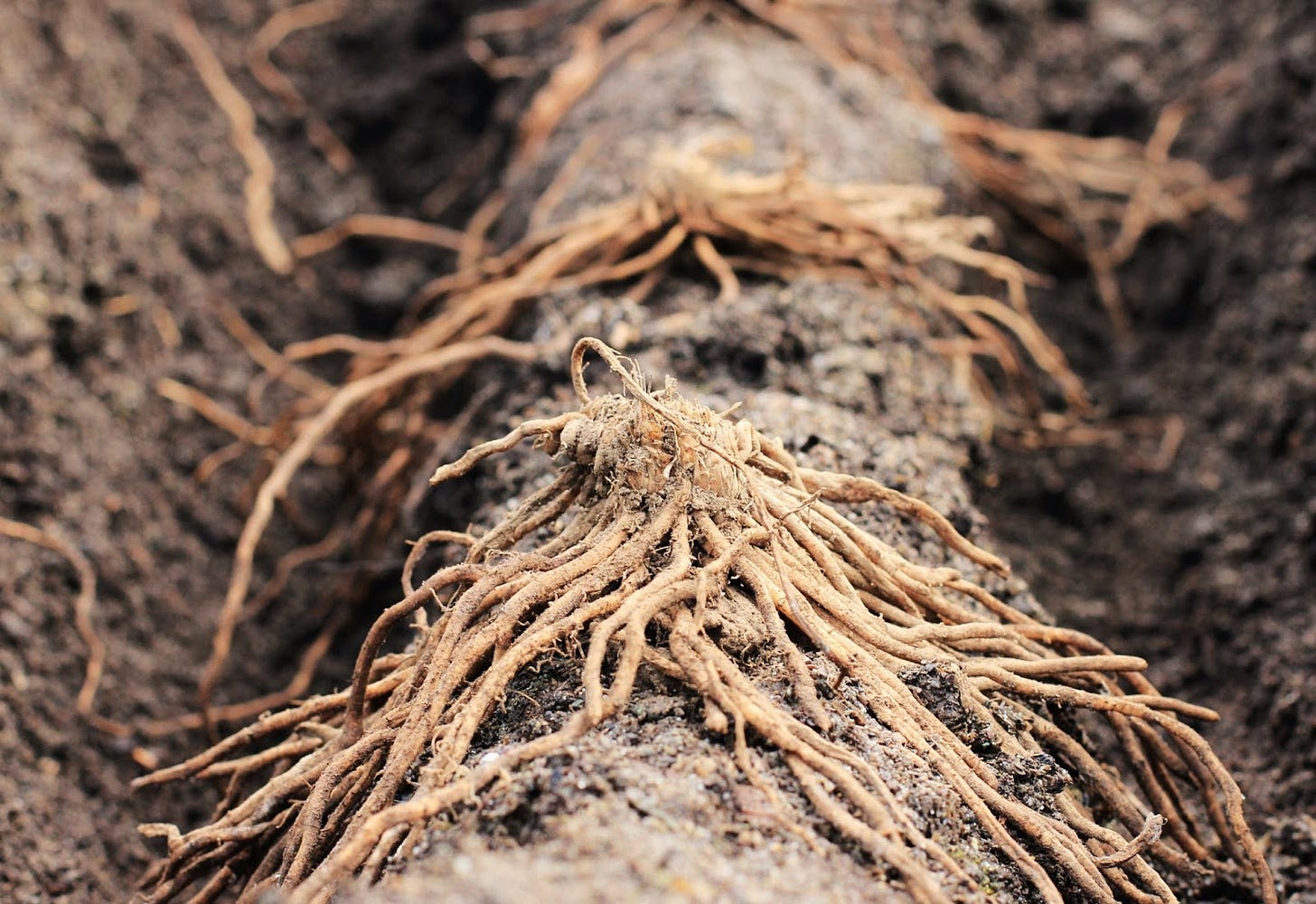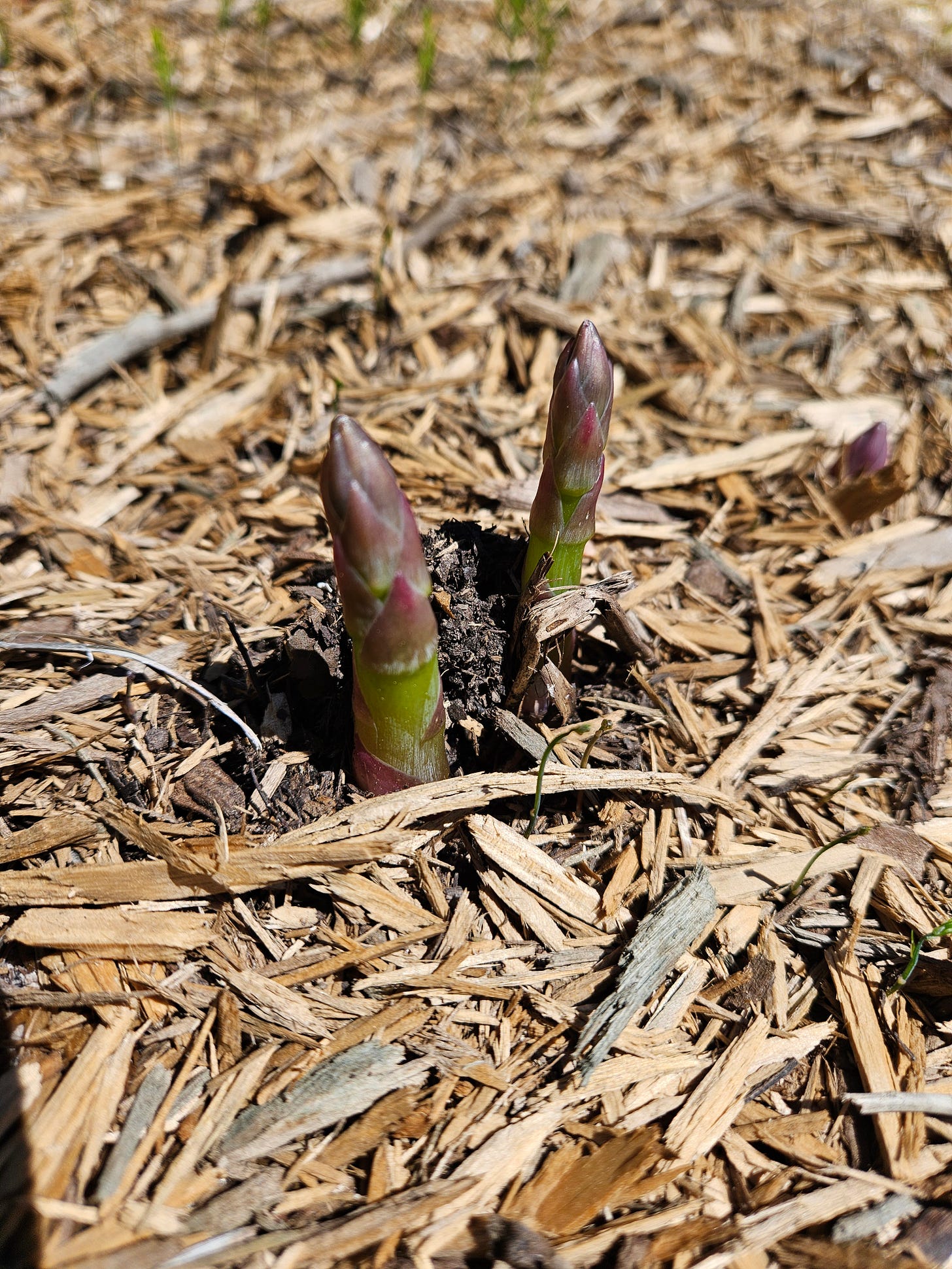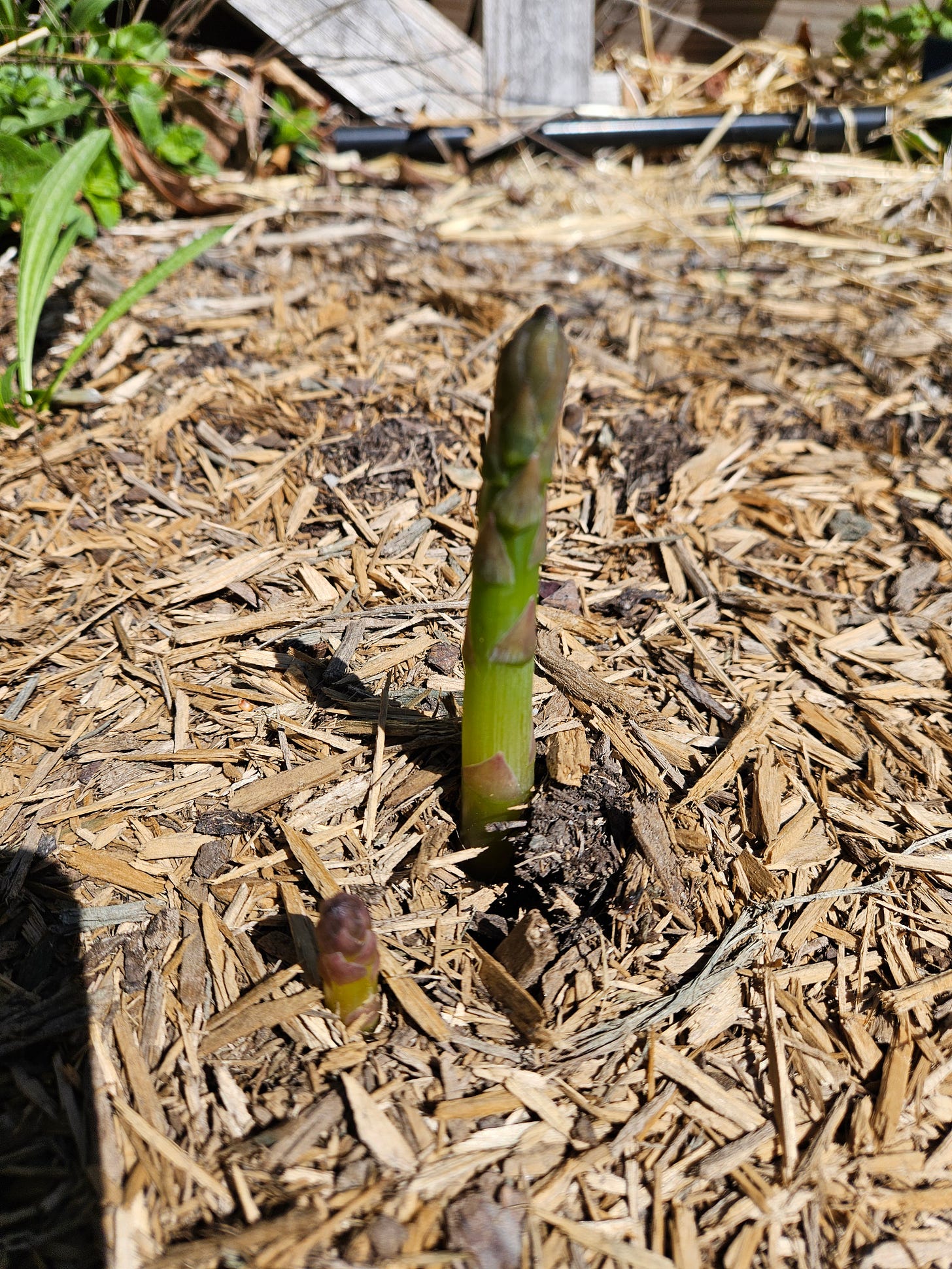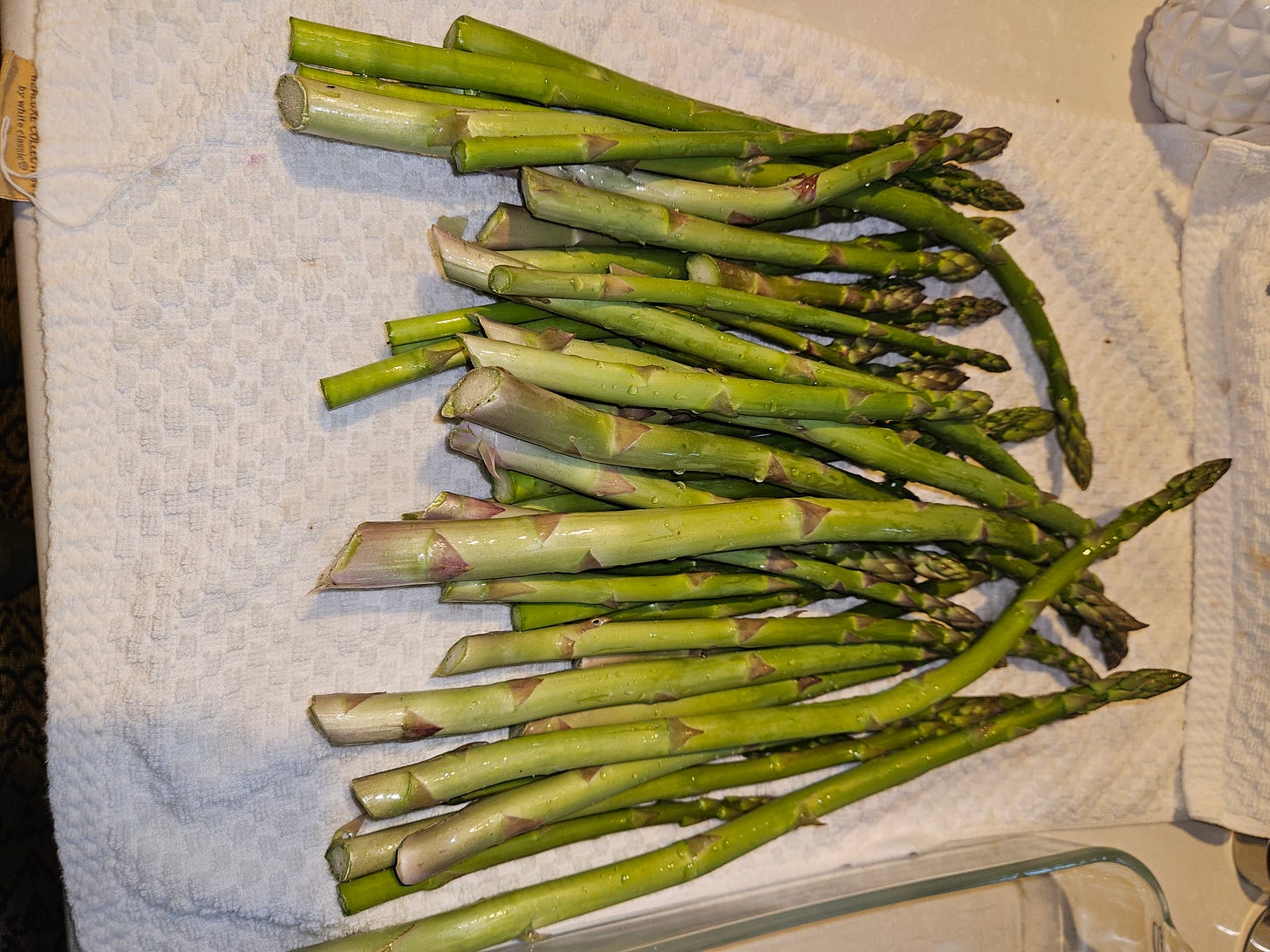Asparagus
May the God of hope fill you with all joy.
When I started my vegetable garden in 2020, one of the things I looked for was a perennial crop—something that would come back year after year and produce vegetables. Our family enjoys asparagus and the plants apparently can live for 15-20 years with proper care, but my original garden did not really have space for asparagus plants.
The following year, I decided to fence in a part of the back pasture that already had posts installed in the ground. After sinking all of the fence posts for the original garden space myself with a manual post hole digging tool, I was not motivated to install more fence posts! I had some deer fencing left over from the garden project the prior year, so I wrapped the posts and created a second garden space. This one would be in ground rather than raised beds.
Once this space became available, planting asparagus made sense. I ordered a box of three-year asparagus root crowns from a farm online. The farm eventually delivered the crowns in the fall of 2021. The anticipated arrival of the crowns prompted me to start digging the trench in which they would be planted. Much like installing fence posts, digging a twenty-five foot long trench with a pick and shovel turned out to be a challenging project. Once the trench was complete, the asparagus crowns arrived and were planted along the bottom of the trench on a small mound I build in the middle. The crowns looked like spiders, and they were laid across the mound to allow the roots to grow out.
I covered the crowns with a mixture of compost and soil, topped with a layer of mulch, and settled in to water and wait. I had read that in order to get the plants to establish well you should wait two years to harvest any spears. Therefore, in the spring of 2022 and 2023, when the spears came out of the ground I left them alone to grow into full plants. In the spring of 2024, I picked a few spears to try them. Delicious! I was not able to get out to the garden frequently enough, however, so once the spears had grown too large to be edible I left them alone to grow another year. I was eagerly anticipating the spring of 2025 to really harvest asparagus.
Once things started to warm up this spring, I laid fresh compost across the entire asparagus bed and a thin layer of mulch for annual maintenance. Then I waited. On Wednesday April 9, I went out to visit the garden and found the first spears peeking out of the ground. Very exciting! It was still cold outside at night for a couple of weeks, so initial growth was very slow.
As we approached the end of April and the weather improved, production increased. I have been surprised to see how quickly asparagus can grow! If I do not get out to the garden twice a week, the spears get overgrown. Last week’s harvest was the largest yet. I anticipate perhaps one or two more weeks of production before I have to let the plants grow out for the season. Over-harvesting the spears can deplete the roots of the sugar necessary to continue their growth into the following years. So, despite the bounty of fresh asparagus, I will have to be prudent and stop harvesting soon.
I have also noticed that some of the asparagus plants that grew berries last year have self-seeded the area around them. The new asparagus plants look like little green ferns growing around the established plant. Although I have more to study and learn about maintaining the new plants, I am excited to see that the asparagus bed may be self-sustaining for years to come.
We recently attended a legal conference out of town. It is an annual conference that I enjoy attending. The lawyers in this organization are top notch professionals and the vast majority are genuinely nice people (which I have found to be somewhat rare in my profession, unfortunately).
We were sitting at dinner one night with a mixed group of people—some couples that we knew from past events and some new people. I was sharing the story about my asparagus with an attorney sitting next to me that we met about four years ago. This attorney is easy to talk to despite his immense success. He was enjoying some of my garden stories—not only the asparagus but the pickup truck at the bottom of the hill.
I had just finished eagerly describing my joy at seeing new asparagus come up this spring and being able to harvest it. My friend was politely and sincerely interested in the story, but the lawyer sitting on the other side of his wife was making a face. He said something along the lines of, “My family was the fourth largest asparagus producer in the country. I don’t want to hear about asparagus.” That was pretty much the end of that line of discussion at the table!
I don’t blame this lawyer for being an asparagus-hater. There is no shame in that. But his decision to interject this comment in the conversation took away my innocent joy in telling a friend about my garden.
I started writing this post about asparagus several weeks ago and hit the wall. What is the spiritual aspect of this story? What direction should I take? The thing that kept coming to mind was the joy-killing conversation at the legal conference. Unfortunately, that did not seem like a good direction to me. The days went by. I would think again about the asparagus post and ask, “What should I write about that?” Again, the dinner conversation came to mind. I finally sat down this morning to tackle this story and see what direction it would go in.
The conclusion I came to is that I should strive to be like my friend who took genuine interest in my innocent joy about my asparagus plants and not to be like the lawyer who threw shade on it. I especially should strive to avoid doing anything to crush innocence or joy in others.
Jesus told us, “Truly, I say to you, unless you turn and become like children, you will never enter the kingdom of heaven.” There is something very precious to Jesus in children and the child-like. Children are fundamentally innocent in spirit and joy rises up easily in them. I have found over the last four years that this is one thing I enjoy about gardening—it allows me to connect to simplicity and innocence in nature. (Spoiler alert—practicing law does not connect me to simplicity and innocence.) This newsletter has been a place for me to share my joy in gardening with others and I am grateful for the positive feedback from readers. Likewise, I want to be a good listener to others when they share their stories of what gives them joy.
Our Lord wants our joy to be full.1 That joy ultimately comes from Him, through the Holy Spirit. The joy of the Lord is very special. The experience of the joy of the Holy Spirit is powerful. The moments of innocent joy that we experience in ordinary life is also special because it is a touch of God. These are moments to cherish and give thanks to God for. We should also be sensitive to the movement of the Holy Spirit in those around us and strive not to quench the joy of the Holy Spirit when it is manifesting to us through them.
The experience of joy ultimately leads us to hope. And hope is the virtue that leads us to heaven. I think the prayer of St. Paul from his Letter to the Romans captures this concept well:
May the God of hope fill you with all joy and peace in believing, so that by the power of the Holy Spirit you may abound in hope.2
I pray that you have an experience of the joy of the Lord today and that it fills you with hope. God loves you!
Eric A. Welter is an employment lawyer and trial attorney with a long-time devotion to intercessory prayer. He is a Catholic Christian who has been involved with intercessory and healing prayer ministry for over twenty years.






I share your joy. Asparagus is something I too would like to add to my garden. Joy in the simplicity of dirt, bugs, plants and seasonal cycles is why I garden. It is participating in God’s handiwork.
May we all learn to be as little children and may our Joy be made complete in The Giver of all good gifts.